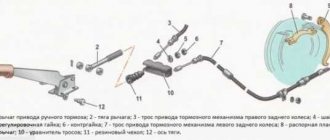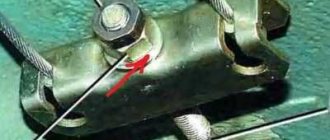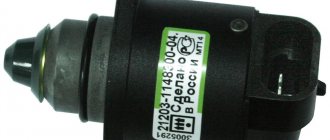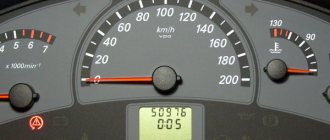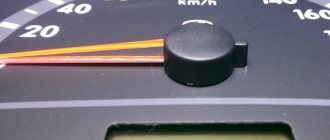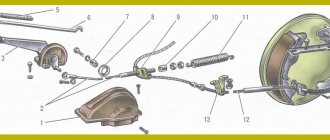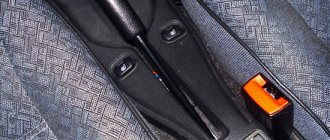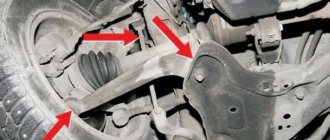Not all motorists use the handbrake, especially in winter, when the brake pads may ice up. In this case, the handbrake begins to jam. But according to traffic rules, you need to use the parking brake for safety reasons. At the same time, the braking system itself must be in good condition. Although sometimes it happens that the handbrake does not hold when turned on. Why this happens and how to fix the problem - all this will be discussed in this article.
Why won't the handbrake hold?
Hand brake device
The principle of operation of the parking brake is quite simple. There is a handle inside the car, to which a special durable braided cable is attached. It is in this braid that the cable runs when the handbrake is turned on. The cable is connected to a bar, from which more cables run on both sides to the rear wheels. There are special brackets at the edges of these cables, which open the brake pads if necessary, thereby blocking the car's wheels.
Parking brake device
If we describe the design of the handbrake in simple words, then when the handle is lifted, the cable in its braid is tensioned and, consequently, the brackets responsible for spreading the rear brake pads are released. The more the handbrake is raised, the more the brake wheels will be spread apart.
How does the handbrake work?
When the driver activates the handbrake, either by pulling the handle between the front seats (3) or by pressing the parking brake pedal under the dashboard, a cable (12) running to the rear of the car is pulled, applying tension to the brake pads. When the driver lowers the handle, the return spring (11) helps return the brake system to its normal configuration.
The system itself is quite simple and banal - the parking brake handle is connected to a cable in a special plastic sheath, in which it can move freely. This cable goes to the adjusting bolt, which can be loosened or tightened. Then it splits into two cables that go to the brakes on the rear wheels.
In simple words, by activating the handbrake, the cable tightens and brings the pads together, which then secure the car.
Characteristic signs of failure
Even a novice can identify a faulty parking brake. As a rule, the following signs indicate this:
- the vehicle is not secured securely after applying the handbrake, the wheels do not lock;
- it takes a lot of effort to lift the handle;
- the unit moves quite easily, no resistance is felt.
Signs of a faulty handbrake
If at least one of the above symptoms appears, you need to check the serviceability of the parking brake. If the unit does not work, it is important to understand why the handbrake does not hold.
What is the importance of system health?
The serviceability of the parking lock is very important, like any other elements included in the list of the car’s braking system. Tasks that a well-functioning handbrake performs:
- Ensures that the machine stops on any uneven terrain (rises, slopes, etc.).
- Helps in situations where the main brake has failed or during emergency braking.
- Creates a controlled skid (requires certain skills).
- Can temporarily replace the main system (when it fails).
But remember - the use of such a mechanism instead of the main system is strictly prohibited, if only because it is not intended for this. As a last resort, when such use is still necessary, do not apply the handbrake too sharply, this can cause the car to skid, provoking a dangerous situation in which both you and other road users may suffer.
The handbrake consists of three main parts:
- Handbrake drive.
- Actuating mechanism.
- Control node.
Causes and solutions
As practice shows, most often the handbrake does not hold for trivial reasons that can be easily corrected. For example, the unit stops functioning normally due to oil getting on the friction material of the brake pads, improper adjustment, jamming or damage to the cable, etc. Now let's talk more about the main reasons.
Causes of parking brake failure
Oil getting on the pads
Even a small amount of oil on the brake pads can cause the parking brake to perform poorly. It is important to identify the cause of the fluid leak. As a rule, this occurs due to damage to the oil seal or brake cylinder. It is necessary to eliminate the leak and clean the surface of the parts.
Oil on brake pads
Note! If the brake pads are very oily, cleaning will not help. They need to be completely replaced.
Brake pad wear
As your vehicle operates, brake pads gradually wear out. If you do not take care of this and do not carry out regular maintenance, then eventually the braking system will not work properly, since most of the friction material on the pads has been worn away. The solution is simple - you need to buy a set of new pads and replace them.
Brake pads are worn out
Incorrect adjustment
Often the parking brake does not work due to an incorrectly adjusted cable system. For example, the length of the cables was chosen incorrectly or errors were made when adjusting the system. In this case, the cables must be tensioned correctly and in accordance with the instructions.
Misaligned handbrake cable system
Dirt on the surface of the pads
Oil is not the only thing that can disrupt the brake system when it gets on the pads. The malfunction may be caused by ice, dirt or dust from the road. Also, reagents used in big cities for sprinkling roads in winter can get on the pads. In this case, it is enough to simply press the brake pedal several times smoothly. When friction occurs, the surface will be cleared of accumulated dirt, and the handbrake will begin to function normally.
Contaminated brake pads
Cable wedge
Another common reason is a jammed cable. This occurs when the special shell inside which the cable begins to move is damaged. In this case, no amount of electrical tape will help. The cable needs to be replaced.
Handbrake cable jammed
Damage to the cable
The cable itself consists of a large number of steel threads, which can break during operation. If the cable is damaged, it may prevent the parking brake from operating. Well, if it is completely torn, then the handbrake becomes useless. The way out is simple - you need a replacement.
Handbrake cable break
How much does it cost to tighten the handbrake and can you do it yourself?
Actually the question is rhetorical, as you understand in different regions, the cost can range from 200 to 1000 rubles. For example, in the capital, the price is often 500 – 1000, but in the regions you can raise it for 250 rubles.
And to be honest, the work itself only takes a few minutes, the main thing is to find a hole or a lift, a key of 10 and off you go. You need to tighten the middle bolt, the one that is in the middle, it is the handbrake, tighten the nut and thereby tighten the cables.
Of course, if they are rusty or torn, then everything is much more complicated; it is better to trust the master, because replacing the cables from the rear drums is not at all an easy task.
That's all, read our AUTOBLOG, I think it clarified the situation.
Similar news
- Anti-squeak plates for brake pads. Why are we needed and...
- How to unscrew a brake pipe. If it has soured and the edges are torn off...
- Rust converter composition. Can I do it myself?
Can I repair it myself?
We need to start with the fact that every motorist has the right to decide for himself: to contact specialists to repair the parking brake or to solve everything on his own. But you need to be prepared for the fact that the cost of adjustment is on average 400-600 rubles. If you are a resident of the capital, then the price tags should immediately be doubled.
Handbrake repair at a service station
You can handle adjusting the handbrake cable yourself. There's really nothing complicated about it. But this only applies to adjustments. If the problem lies in a broken cable, then you should still contact a service center to replace them. This is a more serious breakdown that requires special equipment and skills.
Replacing the handbrake cable
How to solve a problem
Naturally, motorists are interested in what to do if the handbrake is jammed, and how this could turn out.
There are 2 main situations when there are problems with the parking brake:
It would be fair to call the first situation jamming. We’ll tell you more about it.
Since the handbrake does not release and continues to block the wheels, it is important to first exclude the option of freezing. If it is a warm season and there were no frosts at night or while the machine was idle, the jamming occurred precisely for mechanical reasons. Some kind of breakdown occurred.
There are several potential culprits and solutions to the problem here.
- Handbrake cable jammed or broken. It needs to be inspected and adjusted. If the defect is serious, it will have to be replaced.
- Jamming due to rust formation. Relevant for machines that have been idle for a long time and have not been used. At the same time, the car was stored in a humid environment. Rust has stuck to the pads, caliper or brake disc (drum). This will require dismantling, cleaning or replacing elements.
- The pad linings became soggy, which caused them to stick to the drums. You will probably have to solve the problem by replacing the elements.
Some motorists advise trying to move forward and backward, tap the problem unit with a hammer, insert a pry bar into the gap between the jammed block, and manually try to loosen it.
In reality, such actions can lead to serious consequences. It is better to carefully examine the condition of the handbrake, determine the cause of the jamming, and carefully eliminate it by sequential dismantling, or by contacting a car service.
If the problem is related to the fact that the block is frozen, which can be determined by the presence of an ice crust and indirect signs such as driving through puddles and freezing temperatures, it is much easier to solve.
How to solve the problem of the handbrake jamming in the cold
When your parking brake suddenly jams after a long period of parking in the cold, there is a very high probability that the brake pads will freeze.
This problem can be solved quite quickly in several accessible ways.
- Use of defrosters. These are special liquids, mainly alcohol-based. You can find them in specialized stores in the auto chemicals department. The principle of using funds is extremely simple. You need to spray it on the frozen assembly, wait a while, and then try to unlock the handbrake. If you live in a region with cold and wet winters, having such a can with you will never be a bad idea.
- Using a hair dryer. A very reliable, effective and fast way to remove ice from a handbrake. The only problem is that not every motorist has such a hairdryer at his disposal. Plus, to connect you will need a household outlet or a car inverter. An alternative is a regular household hair dryer, but its power is not enough to quickly resolve the issue. You will have to hold the device aimed at the brakes longer. Here the issue of connecting to the power grid remains relevant too.
- Defrosting with its own exhaust pipe. The meaning is quite simple. You will need a rubber hose that is large enough to fit onto the exhaust pipe. It should also be long enough to extend the other end of the hose to the brakes. Next, start the car and begin to warm up. Hot air comes out of the exhaust pipe, it passes through the hose, and warms up the handbrake.
- Available liquids. Another method involves using suitable liquids. These include antifreeze, alcohol or gasoline. They are applied to the pads and waited for some time. As soon as the ice thaws, the handbrake can be unlocked.
And there are 2 methods that should be abandoned. They should only be used as a last resort. And even in this situation it is better to do without such measures.
Some bad ideas for defrosting a jammed handbrake include the following methods.
- Hot water. There is severe frost outside, due to which the pads froze. The brake system elements themselves are also cold. Now imagine that a large amount of hot water or boiling water suddenly hits the parts. This leads to a sharp temperature drop. As a result, the metal may crack. This will lead to breakdown of expensive components and the need to replace them. Therefore, the idea of boiling water is categorically not welcomed.
- Physical impact. Quite often, motorists try to solve the problem of jamming due to freezing or mechanical failures using physical force. Trying to break the handbrake if it is jammed is strongly not recommended. If there is no other way out, you should get behind the wheel, start the engine, and try to rock the car forward and backward with short presses on the gas.
Disrupting the handbrake by physical force can potentially cause serious damage to the suspension and braking system components.
Therefore, these methods are necessarily included in the list of prohibited methods. Only in certain circumstances, when there is no other solution and cannot be, is their use allowed.
It hardly needs saying that lighting an open fire near the car in order to melt frozen pads is the worst idea among all existing ones.
A jammed handbrake is not a rare occurrence. But you can always find a way out of this situation. In some cases, the problem is solved literally in a few minutes, and no expensive repair work has to be carried out. If the jamming is due to a malfunction in the hand parking brake assembly, try to solve the problem yourself, or contact a car service center. If the handbrake sticks, you may need a tow truck to take the car to a service center to fix the problem.
To be honest, the handbrake or handbrake is not particularly needed in the city, especially if you have an automatic car and you have a parking mode . Yes, and in manual mode, drivers mostly put the car in gear. Why? Yes, it’s simple - our climate is harsh, and therefore if you put on the parking brake in winter, you can get into an unpleasant situation - they will simply freeze to the rear drum brakes. However, as the traffic rules teach us, you need to set it to avoid emergency situations, for example, you left the car in neutral gear, forgot to put the handbrake on - GONE, and it rolled. It's not far from an accident! Therefore, when undergoing maintenance, this braking element must be checked; if it does not work (does not hold), then you will not pass the technical inspection. But why does this happen, what are the reasons? Let's find out...
THE CONTENT OF THE ARTICLE
The handbrake or handbrake is just a scourge on our VAZs. Very often it turns out that you lift the handle of this brake, but nothing happens - that is, the car rolls.
When undergoing a technical inspection, there is a golden rule:
If the car stops after three clicks, it means the handbrake is working and you can issue the coveted ticket. But if it doesn’t hold well with 4 or more clicks, then the performance is at a low level, or it doesn’t exist at all!
Faulty cars are sent to be repaired or the handbrake tightened, without it there is no way.
Diagnostic features
A handbrake malfunction is not always associated with incorrect adjustment, so before starting repair work it is important to determine the cause of the malfunction. Many car owners rely on car service workers, where the operation of the parking brake is checked using a special stand. But there are other, no less effective diagnostic methods.
Handbrake diagnostics
To check the handbrake, you need to jack up the rear wheel of the car, apply the handbrake and turn the wheel manually. If the wheel still turns when the handbrake is tightened, then the brake system is not working properly. Then either adjustment of the system or replacement of its individual elements is required.
Handbrake on rear disc brakes
In order to pay more attention to the adjustment process and not go into the intricacies of the operating principle of a mechanically driven parking brake on disc brakes, we will list only the main types of device.
- The brake disc is held by an additional pad, which, when the handbrake is raised, is pressed against the working surface of the disc by means of a rocker arm.
- The brake disc design allows individual brake pads to be placed in the internal cavity. The operating principle is similar to that of drum brakes.
- Design with mechanical support of the working piston. In the cavity of the brake piston there is a ratchet (for automatically bringing the pads together), into which a pin with a trapezoidal thread rests. The curved rod drives the pin by turning the shaft with a concentric groove.
Adjustment
In the case of the most common drum type of design, the handbrake can be adjusted by rotating the adjusting pawl. The regulator itself can be located on the side or bottom of the brake mechanism. Access to it is through a technological hole in the shield, which must be covered with a plug.
In some types of construction, the regulator may be locked by a spring element, so it will have to be bent to release and rotate the “pawl”. The handbrake design on the rear disc brakes and the adjustment mechanism are perfectly shown in the video.
The parking brake, or as it is popularly called the “handbrake,” although it is intended to immobilize the car while parking, not all drivers and do not always use it. If the car has an automatic transmission, then, by and large, a handbrake is not needed at all, but owners of cars with manual transmission, as a rule, prefer to leave the car in first gear when parking. This is due to one of the most important reasons - harsh winter conditions and poor road quality may not allow the handbrake to operate when necessary. This may be caused by icing on the pads or clogged pads. But first things first.
Adjusting the parking brake
The technology for adjusting the classic end handbrake is the same for all models and brands of cars. There is only one difference: the settings can be done from under the car or directly from the interior. Most often, adjustment is carried out using the second method.
Adjusting the hand brake
- Tighten the handbrake a few clicks.
- Raise one side of the car using a jack. If there is an inspection hole, this will make the work easier.
- Find the special tightening nut on the adjusting unit and loosen it slightly. Slow rotation of the second nut tightens the handbrake cable.
- When tightening, you need to monitor the change in braking force on the wheel.
- Lower the parking brake handle in the passenger compartment and check the adjustable wheel for rotation.
- Tighten the handbrake and check the suspended wheel to see if it rotates. It is important to ensure that the parking brake operates consistently. After this, the locknut must be tightened.
Repairing the parking brake on a car
Now about the second method - about adjusting the handbrake from under the car. The main problem here is the inaccessibility of some elements. It will be difficult to get to the adjusting screw. Typically, adjustments require removing the panel. This is a more complex method, so most drivers prefer another method.
Five mistakes when using a handbrake that shorten its life
It's no secret that a mechanical handbrake is used during sports driving to send the car into a turn.
To do this, when entering a bend, the driver temporarily blocks the wheels of the rear axle by sharply, briefly tightening the handbrake, provoking a slip, and in some cases the drifter “plays” with the degree of tightening of the parking brake, building the desired trajectory.
What is the danger? Firstly, you can overestimate your driving strength and cause an uncontrolled skid. In addition, when drifting with the handbrake, there is an extreme impact on the handbrake mechanisms. The most common consequence is stretching or even breaking of the cable. At the same time, increased wear of the brake mechanisms is provoked.
Almost every driver has started driving at least once, forgetting to release the parking brake. What are the consequences of this situation?
An inattentive driver may not notice the indicator on the instrument panel and continue driving, not realizing that the car is moving with noticeable force.
The further and longer it travels, the more the brakes heat up (this can lead not only to wear of the pads and brake discs, but also to overheating of the discs, calipers and brake cylinders). And the fact that the handbrake cable will stretch is almost inevitable. In addition, the engine and transmission will work when driving with the handbrake under increased load, and uneven and rapid tire wear will occur.
In winter, drivers should, if possible, avoid putting the car on the “handbrake” after a long and intense drive, car washes, driving through puddles and before a sharp cold snap. It is better to lock the car in gear (manual) or in Parking mode (automated gearboxes).
Otherwise, if the handbrake is too tight, the brake pads may freeze to the drums or disc, and when you decide to start in the morning, the rear brakes will simply jam. If you continue driving in such a situation, you can damage both the main brake mechanism and the elements of the hand brake. Therefore, if you find yourself in such a situation, try to warm up the frozen mechanism with warm water by pouring it onto the brake drum or disc from a bottle or kettle.
Or, say, if you have a hose in stock, you can put it on the exhaust pipe and direct the other end to the brakes to warm them up with exhaust gases. In the case of drum brakes, you can also remove the rear wheels one by one and tap the “drums” through a wooden spacer. With disk mechanisms everything is even simpler. The usual “wash” will help to defrost them, which will need to be poured directly onto the pads.
Many drivers have the habit of tightening the handbrake as hard as they can, literally as long as they have enough strength, and even fragile girls are guilty of this. The general rule is that on a car with a properly adjusted mechanical parking brake there should be approximately three to four clicks and certainly no more than eight.
There is another extreme - raise the handbrake to just one or two clicks. This may be enough to lock the wheels and keep the car on a slope. By the way, to check the correct setting of the parking brake at home, you need to tighten it to the fullest, engage first gear and smoothly release the clutch (on cars with manual transmission). If the parking brake is working properly, the engine should stall, but if the car starts moving, the handbrake is not in order - it should be adjusted (tightened) at a service center.
The habit of using only the handbrake, without also using the gear (mechanics) to secure the car, is a bad habit.
A scenario cannot be ruled out, especially on a slope of more than 10 degrees and especially on a wet surface or whatever, when the force of the handbrake is not enough and the car goes into “free swimming”.
The likelihood of this increases if the handbrake is set incorrectly or the tension has weakened due to the errors described above. A special case is when you leave the car in “handbrake” for a long time (a month or more). In this case, it is possible that the pads will stick to the discs. Therefore, if you park your car for a long time, for example, in a garage, put the car in gear and place bricks or wheel chocks under the wheels.
The handbrake doesn't hold
The presented article and video are devoted to adjusting the handbrake, but in some cases the handbrake does not hold due to worn brake pads or lack of a cable. If the handbrake has not worked since you purchased the car, before starting the adjustment, make sure that the cable is not cut due to natural wear or poor fastening.
Drum brakes
The easiest way to adjust the parking brake is on a drum brake system. Schematic representation of the VAZ 2113-15 hand brake device.
Raising the handbrake lever moves the rod (5), from which the cable contours pass to each of the wheels under the bottom of the car. After passing through the brake shield, the cables are connected to the hand block control levers. When the parking brake is raised, the cable acts on the lever (13), the upper part of which is fixed to the axle (12). As a result, the force created by the lever through the expansion bar is evenly transmitted to the brake pads, pressing them against the drums.
Some types of construction use a combination of rods instead of cables, but it is the device described above that can be found on all modern cars with rear drum brakes.
How to tighten the cable
The essence of the adjustment is to move the leveling cable along the rod towards the front of the car. Depending on the design of the car, the adjustment mechanism can be located in the passenger compartment or under the bottom, as is the case with VAZ 2115,2114,2113,2199,2109,2108, Opel Astra F and many other cars.
To access the adjustment mechanism located in the cabin, there is often a special hatch in the central tunnel. In our case, the process is described and shown in the video using the example of a car, where the adjustment is made under the bottom, so the car first needs to be driven along an overpass or inspection hole. Instructions that will allow you to tighten the cable if you do not hold the handbrake.
- Clean the threads of the adjuster rod with a wire brush.
- Loosen the locknut. To add rigidity to the structure when unscrewing and tightening it back after adjustment, you will need 2 wrenches: with one you need to hold the adjusting nut while unscrewing, and with the second you need to unscrew the lock nut.
- Move the adjusting nut into position by turning it the required number of turns.
- Once the adjustment is complete, tighten the locknut until it locks into the adjusting nut.
What degree of tension is considered correct?
In the case of technical inspection, which is not carried out on civilian vehicles in the Russian Federation, the effectiveness of the hand brake is checked in two ways:
- a vehicle with a full curb weight must be securely secured with a hand brake on a slope of 16º or 25º, depending on the current requirements;
- The effect of the handbrake is checked on special drums. In this case, not only the braking force is measured, but also the uniformity of its distribution between the rear wheels.
Traditional methods
When automatically adjusting the parking brake, there are two ways to evaluate the parking brake cable tension:
- by the number of clicks. In this case, you need to look for information on a specific car model, since, for example, for a Daewoo Matiz the norm will be 7 clicks, and for a VAZ 2106 - 2-4 clicks. The only drawback to the adjustment is that sometimes after replacing the brake drums, pads and maintaining the average number of clicks, even with the handbrake down, the pads may be pressed too tightly against the drums. Therefore, after servicing the rear drum brakes, the degree of tension should differ from the average requirements, but after grinding in, the handbrake will need to be tightened;
- depending on the degree of compression of the friction linings. To adjust the parking brake, the rear wheels will need to be suspended. It is necessary to tighten the cable so that when the parking brake lever is lowered, the shoes barely touch the brake drums. When rotating by hand, the wheel should rotate quite freely, but a barely audible sound will be heard from the friction linings pressed against the drums (if the pads are worn unevenly, the characteristic sound during rotation will be somewhat different from the position of the wheel). With this adjustment, after traveling 100-200 km, the friction linings wear out a little and the gap becomes close to ideal.
VAZ owners
On VAZ cars with a front-wheel drive layout, the handbrake may not hold well, even if you tighten the cable in time. This is due to the design of the cable end, which limits the range of movement of the hand pad control lever. When you apply the handbrake, the return spring is pushed into the detent too quickly. To solve this problem, the owners cut out several turns of the return spring. In this case, you need to be very careful not to damage the parking brake cable itself, and also ensure that the removed segments are the same length on both sides.
